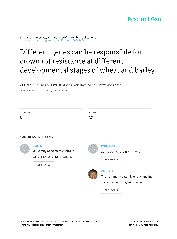摘要
Crown rot, caused by several Fusarium species, is one of the most damaging diseases in wheat and barley. Growing resistant varieties has long been recognised as an integral part in effectively managing the disease. One of the factors hindering the progress of breeding for crown rot resistance is the lack of a reliable and high throughput bioassay that allows rapid and accurate assessment of large numbers of genotypes so that highly susceptible materials can be quickly rejected and potentially resistant lines identified for more focused further assessments. We developed a method which, by growing several inoculated seedlings wrapped in a single piece of moist paper towel, offers significant advantages over all of the existing methods. The new soil-less assay takes only about two weeks, requires very little space, and removes variability associated with the use of soil/potting mixes. Results from the new assay are highly reproducible and agree well with known field performances of different varieties. However, mapping studies conducted using the new soil-less assay did not detect all of the quantitative trait loci found with a soil-based assay. These results show that, although different resistance genes may all contribute to the performance of a variety, caution should be used when comparing results from different assays.
- 出版日期2010-12
- 单位江苏省农业科学院; CSIRO
